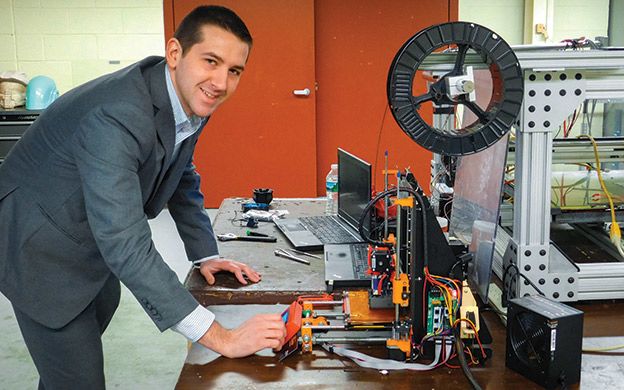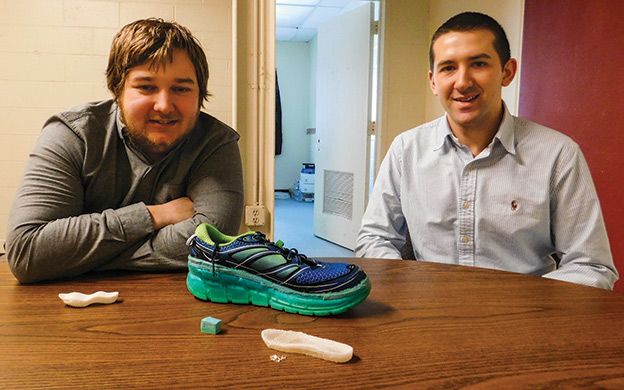Processing Your Payment
Please do not leave this page until complete. This can take a few moments.
- News
-
Editions
View Digital Editions
Biweekly Issues
- December 15, 2025
- December 1, 2025
- Nov. 17, 2025
- November 03, 2025
- October 20, 2025
- October 6, 2025
- + More
Special Editions
- Lists
- Viewpoints
-
Our Events
Event Info
Award Honorees
- Calendar
- Biz Marketplace
Bangor startup applies new 3-D technology to accelerate the shoe-making process
 Photo / Lori Valigra
Andrew Katon, CEO and president of L&K (dba Cobbler Technologies) of Bangor, stands before a hobby 3D printer that is making parts for his prototype commercial 3D printer in the background (metal frame).
Photo / Lori Valigra
Andrew Katon, CEO and president of L&K (dba Cobbler Technologies) of Bangor, stands before a hobby 3D printer that is making parts for his prototype commercial 3D printer in the background (metal frame).
 Photo / Lori Valigra
Robotics engineer Tim Abraham (left) with L&K CEO/President Andrew Katon with shoe sole parts made with the company’s prototype 3D printer. The company made a proof-of-concept sole to see how it measured up against the sole on a commercial running shoe.
Photo / Lori Valigra
Robotics engineer Tim Abraham (left) with L&K CEO/President Andrew Katon with shoe sole parts made with the company’s prototype 3D printer. The company made a proof-of-concept sole to see how it measured up against the sole on a commercial running shoe.
When your favorite sneakers finally fall apart, you can see the various layers of foam, rubber and other materials that make up the sole.
As it turns out, what looks like a solid slab of rubber from the outside is quite intricate inside, making it the most expensive and time-consuming part of the sneaker to produce. And the process of making soles hasn't changed in almost 50 years.
That spelled opportunity to Bangor startup L&K Manufacturing, doing business as Cobbler Technologies. The company found that sport shoe makers around the globe are looking for ways to make the sole cheaper, faster and with the new materials their initial elite clients expect for better comfort and performance.
One top tech choice for shoemakers is 3-D printing, which lets them experiment more easily with prototypes and get to production more quickly. Cobbler President and CEO Andrew Katon thinks he has found a better mousetrap to make 3-D printing even faster and more flexible, and in the process, modernize New England's tradition in shoemaking.
“Shoe companies want to use materials they already use,” says Katon. “What doesn't exist in the 3-D printing market now is a printer in which you can swap out materials [easily].”
Cobbler's technology can print several materials without an operator having to stop the printer, change the material and the print head to handle it. Change-outs translate into downtime on the factory floor. The Cobbler Atomized Particle Deposition 3-D printer will enable construction of multi-material products and mix the materials as they're added.
The company's development-stage atomized particle deposition, or 3DADP printer nozzle technology, lets the printer deposit customized layers of materials in three dimensions. Those materials start out as tiny beads about half the size of a pea, and are fed into the printer, where they are atomized so they blend together to create a multi-layered sole.
“Our focus is on simplicity and automation,” says Katon. In the adjoining room, parts for his new printer are being built by a small 3-D printer made from a kit by Tim Abraham, the company's robotics engineer. The two men met as students at the University of Maine, Orono, in 2015.
Abraham says he was walking to robot club when he saw Katon working on his 3-D printer in a room, and became intrigued. Both are mechanical engineers.
“We can talk and disagree on things,” says Abraham, adding that the give-and-take is good because together they can come up with better ideas.
When Cobbler's printer is completed, it will measure about four feet both wide and deep and be three feet high, weigh 400 pounds and sell for $100,000 to $400,000, depending on the machine's efficiencies and the cost of the components it produces. Katon says he is talking to partners to test and use the printer and hopes to have someone lined up in the next few months. He says every major shoe company is exploring faster, better and cheaper ways to make shoes.
The stakes are high. Transparency Market Research of Albany, N.Y., has pegged the overall value of the global footwear market at $209 billion in 2014, rising to $258 billion by the end of 2023.
Ultimately, Katon says, he'd like to be able to print an entire shoe. He also wants to target other markets than shoes for athletes, including nurses, police and construction workers who are on their feet all day and need more comfortable and supportive footwear.
Origins of a startup
College contacts can lead to collaborations that in turn lead to startup companies in an ideal innovation system. L&K Manufacturing, which started as a 3-D printer service company that made parts for other companies, emerged after Katon and another student, Vincent Lewis, met at UMaine, Orono. Lewis has since returned to school for his PhD, and has left the company.
While at UMaine, Lewis and Katon developed a manufacturing process for Alba-Technic of Winthrop. That company makes protective headgear for athletes and the elderly. The two launched the company in June 2014 after their senior capstone design build test of the manufacturing process for Alba-Technic.
Initially, L&K made prototypes for commercial products and the aerospace industry. It generated $100,000 in revenue, but the company changed focus to build its own 3-D printers.
Because soles from a 3-D printer are very stiff, Katon tried making a more flexible sole using a Hoka running shoe to see if Cobbler could make a different, flexible material and glue it on as a proof of concept.
“Typically a 3-D printer will print a very stiff sole, so many shoe manufacturers are experimenting with them to try to get better soles,” he says, showing a flexible, thin white soul made from the tiny beads.
He adds that it can take a shoe company $3 million to set up and tool a new product line and two years total to get it to market. He saw opportunity in hastening that process and making it less costly.
Now focused on developing, making and selling 3-D printers, Cobbler raised capital of $350,000 from angel investors in Maine and one in Boston. Katon declined to reveal who they are but listed in various U.S. Securities and Exchange Commission filings are Peter Klein, former CEO of Auburn manufacturer KICTeam & Enefco International who is Cobbler's chairman of the board, and Thomas Marlow, an intellectual property specialist who is also a Cobbler board member.
In its recent SEC amended filing, Cobbler sold $150,000 of a $250,000 equity raise coupled with Series AA preferred stock. It also has a $65,000 loan from CEI that is backed by FAME.
“We've sold about 20% of the company in equity to angel investors,” Katon says.
Additional help came from French company Dassault Systèmes, which gave Cobbler the equivalent of $50,000 in manufacturing software.
Katon says Cobbler is getting notice outside Maine, having been invited to pitch at the Venture Summit West from Feb. 28-March 1 in Mountain View, Calif.
Accelerated help
Fortunately for Katon, his location near Orono provided ready access to two of the state's key innovation accelerator programs. Katon and Lewis were among the companies in the Maine Center for Entrepreneurial Development's 2015 Top Gun class as well as the Scratchpad Accelerator, a UMaine initiative in collaboration with the Maine Technology Institute.
Top Gun Prep and Top Gun helped the duo learn how to start a business and learn the intricacies of business, while the Scratchpad Accelerator taught them how to plan for scale, get funding and take the company to a commercial scale. Scratchpad also gave them $25,000.
“The [Scratchpad] program guides entrepreneurs through the early stages of business development to help them improve their chances of success,” Katon says. “Our initial focus is the sole and over time possibly progress to do a full shoe like a Croc.”
The company hopes to have 12 to 14 patents filed or granted in the next five years.
“Our focus now is to find a launch partner to beta test the product,” Katon adds. “We are in final discussions with a partner [that we expect to finalize] in the next few months.”
L&K Manufacturing Inc. (dba Cobbler Technologies)
40 Johnson St., Bangor
Products: Multi-material, 3-D printers for the footwear industry
Founded: June 2014
CEO/President: Andrew Katon
Employees: 2 full-time, 3 part-time
Funding: $350,000 raised via angel investors, with a $65,000 CEI/FAME loan
Contact: cobblertechnologies.com / akaton@cobblertechnologies.com / 286-5306
Mainebiz web partners

The Giving Guide
The Giving Guide helps nonprofits have the opportunity to showcase and differentiate their organizations so that businesses better understand how they can contribute to a nonprofit’s mission and work.
Learn More
Work for ME
Work for ME is a workforce development tool to help Maine’s employers target Maine’s emerging workforce. Work for ME highlights each industry, its impact on Maine’s economy, the jobs available to entry-level workers, the training and education needed to get a career started.
Learn More
Groundbreaking Maine
Whether you’re a developer, financer, architect, or industry enthusiast, Groundbreaking Maine is crafted to be your go-to source for valuable insights in Maine’s real estate and construction community.
Learn more-
The Giving Guide
The Giving Guide helps nonprofits have the opportunity to showcase and differentiate their organizations so that businesses better understand how they can contribute to a nonprofit’s mission and work.
-
Work for ME
Work for ME is a workforce development tool to help Maine’s employers target Maine’s emerging workforce. Work for ME highlights each industry, its impact on Maine’s economy, the jobs available to entry-level workers, the training and education needed to get a career started.
-
Groundbreaking Maine
Whether you’re a developer, financer, architect, or industry enthusiast, Groundbreaking Maine is crafted to be your go-to source for valuable insights in Maine’s real estate and construction community.
ABOUT
NEW ENGLAND BUSINESS MEDIA SITES
No articles left
Get access now
In order to use this feature, we need some information from you. You can also login or register for a free account.
By clicking submit you are agreeing to our cookie usage and Privacy Policy
Already have an account? Login
Already have an account? Login
Want to create an account? Register
Get access now
In order to use this feature, we need some information from you. You can also login or register for a free account.
By clicking submit you are agreeing to our cookie usage and Privacy Policy
Already have an account? Login
Already have an account? Login
Want to create an account? Register







Comments